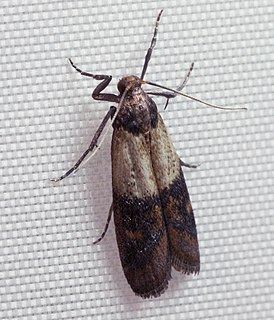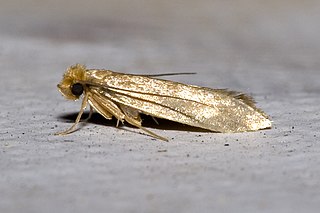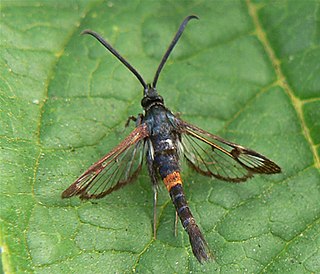
Caterpillars are the larval stage of members of the order Lepidoptera.

Lepidoptera is an order of insects that includes butterflies and moths. About 180,000 species of the Lepidoptera are described, in 126 families and 46 superfamilies, 10 percent of the total described species of living organisms. It is one of the most widespread and widely recognizable insect orders in the world. The Lepidoptera show many variations of the basic body structure that have evolved to gain advantages in lifestyle and distribution. Recent estimates suggest the order may have more species than earlier thought, and is among the four most speciose orders, along with the Hymenoptera, Diptera, and Coleoptera.

Moths are a paraphyletic group of insects that includes all members of the order Lepidoptera that are not butterflies, with moths making up the vast majority of the order. There are thought to be approximately 160,000 species of moth, many of which have yet to be described. Most species of moth are nocturnal, but there are also crepuscular and diurnal species.

Bombyx mori, the domestic silk moth, is an insect from the moth family Bombycidae. It is the closest relative of Bombyx mandarina, the wild silk moth. The silkworm is the larva or caterpillar of a silk moth. It is an economically important insect, being a primary producer of silk. A silkworm's preferred food are white mulberry leaves, though they may eat other mulberry species and even the osage orange. Domestic silk moths are entirely dependent on humans for reproduction, as a result of millennia of selective breeding. Wild silk moths are not as commercially viable in the production of silk.

The Luna moth also known as the American moon moth is a Nearctic moth in the family Saturniidae, subfamily Saturniinae, a group commonly known as giant silk moths. It has lime-green colored wings and a white body. The larvae (caterpillars) are also green. Typically, it has a wingspan of roughly 114 mm (4.5 in), but can exceed 178 mm (7.0 in), making it one of the larger moths in North America. Across Canada, it has one generation per year, with the winged adults appearing in late May or early June, whereas farther south it will have two or even three generations per year, the first appearance as early as March in southern parts of the United States.

Bookworm is a general name for any insect that is said to bore through books.

The Tortricidae are a family of moths, commonly known as tortrix moths or leafroller moths, in the order Lepidoptera. This large family has over 11,000 species described, and is the sole member of the superfamily Tortricoidea, although the genus Heliocosma is sometimes placed within this superfamily. Many of these are economically important pests. Olethreutidae is a junior synonym. The typical resting posture is with the wings folded back, producing a rather rounded profile.

The Pyralidae, commonly called pyralid moths, snout moths or grass moths, are a family of Lepidoptera in the ditrysian superfamily Pyraloidea. In many classifications, the grass moths (Crambidae) are included in the Pyralidae as a subfamily, making the combined group one of the largest families in the Lepidoptera. The latest review by Eugene G. Munroe and Maria Alma Solis retain the Crambidae as a full family of Pyraloidea.

Waxworms are the caterpillar larvae of wax moths, which belong to the family Pyralidae. Two closely related species are commercially bred – the lesser wax moth and the greater wax moth. They belong to the tribe Galleriini in the snout moth subfamily Galleriinae. Another species whose larvae share that name is the Indian mealmoth, though this species is not available commercially.

The bogong moth is a temperate species of night-flying moth, notable for its biannual long-distance seasonal migrations towards and from the Australian Alps, similar to the diurnal monarch butterfly. During the autumn and winter it is found in southern Queensland, western New South Wales, western Victoria, and also in South and Western Australia. Adult bogong moths breed and larvae hatch during this period, consuming winter pasture plants during their growth. During the spring, the moths migrate south or east and reside in mountains such as Mount Bogong, where they gregariously aestivate over the summer until their return towards breeding grounds again in the autumn.

The winter moth is a moth of the family Geometridae. It is an abundant species of Europe and the Near East and a famous study organism for evaluating insect population dynamics. It is one of very few lepidopterans of temperate regions in which adults are active in late fall and early winter. The adults use endothermy for movement in these cold temperatures. The female of this species is virtually wingless and cannot fly, but the male is fully winged and flies strongly. After the initial frosts of late fall, the females emerge from their pupa, walk to and up trees, there emitting pheromones in the evening to attract males. Fertilized, she ascends to lay, on average, around 100 eggs. Typically, the larger the female moth is the more eggs she lays.

The brown-tail moth is a moth of the family Erebidae. It is native to Europe, neighboring countries in Asia, and the north coast of Africa. Descriptions of outbreaks, i.e., large population increases of several years duration, have been reported as far back as the 1500s. The life cycle of the moth is atypical, in that it spends approximately nine months as larvae (caterpillars), leaving about one month each for pupae, imagos and eggs. Larvae (caterpillars) are covered in hairs. Two red spots on the back, toward the tail, distinguish these species from other similarly hairy moth larvae. The winged adults have white wings and a hairy white body with a tuft of brown hair at the tip of the abdomen. Females lay one egg cluster, usually on the underside of a leaf of a host plant. The species is polyphagous, meaning that it feeds on many different species of trees, including pear, apple, maple and oak.

The Indianmeal moth, also spelled Indian meal moth and Indian-meal moth, is a pyraloid moth of the family Pyralidae. Alternative common names are weevil moth, pantry moth, flour moth or grain moth. The almond moth and the raisin moth are commonly confused with the Indian-meal moth due to similar food sources and appearance. The species was named for feeding on Indian meal or cornmeal, and does not occur natively in India. It is also not to be confused with the Mediterranean flour moth, another common pest of stored grains.

The Limacodidae or Eucleidae are a family of moths in the superfamily Zygaenoidea or the Cossoidea; the placement is in dispute. They are often called slug moths because their caterpillars bear a distinct resemblance to slugs. They are also called cup moths because of the shape of their cocoons.

Tineola bisselliella, known as the common clothes moth, webbing clothes moth, or simply clothing moth, is a species of fungus moth. It is the type species of its genus Tineola and was first described by Arvid David Hummel in 1823. The specific name is commonly misspelled biselliella – for example by G. A. W. Herrich-Schäffer, when he established Tineola in 1853.

The lesser wax moth is a small moth of the snout moth family (Pyralidae) that belongs to the subfamily Galleriinae. The species was first described by Johan Christian Fabricius in 1794. Adults are about 0.5 inches (13 mm) in length and have a distinct yellow head with a silver-grey or beige body. Lesser wax moths are common in most parts of the world, except in areas with cold climates. Their geographic spread was aided by humans who inadvertently introduced them to many regions worldwide.

The diamondback moth, sometimes called the cabbage moth, is a moth species of the family Plutellidae and genus Plutella. The small, grayish-brown moth sometimes has a cream-colored band that forms a diamond along its back. The species may have originated in Europe, South Africa, or the Mediterranean region, but it has now spread worldwide.

Galleria mellonella, the greater wax moth or honeycomb moth, is a moth of the family Pyralidae. G. mellonella is found throughout the world. It is one of two species of wax moths, with the other being the lesser wax moth. G. mellonella eggs are laid in the spring, and they have four life stages. Males are able to generate ultrasonic sound pulses, which, along with pheromones, are used in mating. The larvae of G. mellonella are also often used as a model organism in research.

Synanthedon myopaeformis is a moth of the family Sesiidae and the order Lepidoptera. In Europe it is known as the red-belted clearwing and in North America as the apple clearwing moth. The larvae create galleries under the bark of fruit trees, especially old trees with damaged trunks. During this process, the larvae cause significant damage to host trees. Particular attention has been paid to the damage they cause to apple trees. Their status as a pest of apple orchards has led to many research projects aimed at controlling populations of the moth. This moth is native to Europe, the Near East and North Africa. Recently, the moth was introduced into North America, being first detected in Canada in 2005. There are several organisms that threaten the larvae, including parasitoids, nematodes, and bacteria.

Lymantria dispar dispar, commonly known as the gypsy moth, European gypsy moth, North American gypsy moth, or spongy moth, is a species of moth in the family Erebidae that is of Eurasian origin. It has a range that extends over Europe, Africa, and North America.



















